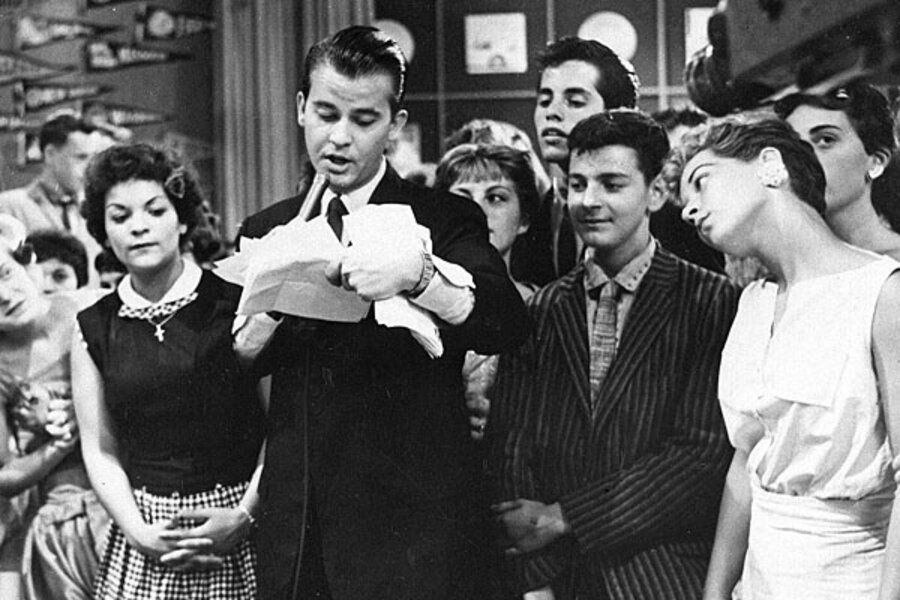Dick Clark: how a tax-accountant look-alike changed American music
Loading...
| Los Angeles
In recent years, Dick Clark had become best known perhaps as the familiar and welcoming face of the New Year’s Eve ball-dropping countdown ritual he introduced in 1972, which he hosted from New York's Times Square for more than four decades.
But the more singular and lasting legacy that makes him a forever-important figure in American culture is what he did for making rock 'n' roll palatable to cynical and even fearful audiences. He played a crucial role in integrating black music into the American mind-set, both audibly and visually.
Behind his eminently ease-producing persona was a entrepreneur who understood the racial nuances of the post-civil rights era and how to promote barrier-breaking behavior in ways that broadened taste and acceptance.
“Dick Clark’s most important contribution is that, through 'American Bandstand,' he assisted in giving rock 'n' roll a soft landing on planet earth and all of America,” says Robert Thompson, founder of the Bleier Center for the Study of Television and Popular Culture at Syracuse University. “A lot of people felt very threatened by the rise of this music and its proponents, but here was a guy who looked more like your tax accountant than any of the people they feared … and that comforted a lot of people. He was like the Trojan Horse that snuck rock 'n' roll into American living rooms.”
Clark, who died Wednesday, was also a business-marketing genius who, having grown up in Philadelphia, grasped the racial zeitgeist of the day firsthand and knew how to massage it winningly on camera.
“He understood that African-American performers were going to be popular with sections of the white population that did not want to socialize with African-Americans, so his show had both those dimensions,” says Mark Naison, professor of African-American studies and history at Fordham University in New York.
Mr. Naison says Mr. Clark understood that the musical barriers being torn down were coming from black artists that most white parents didn’t want their kids dancing with, so he made sure there were only one or two black couples on the show each week.
“He had all these great artists on the show from Chubby Checker to the Drifters but only one or two black couples and never a mixed-race couple,” Naison says.
By contrast, Alan Freed's show, "Big Beat" – the first nationally televised rock 'n' roll dance program – was cancelled after singer Frankie Lymon danced with a white girl.
“Since he was from Philly, he understood exactly the taboos and went national with a formula that only pushed existing boundaries so far,” says Naison, calling Clark “seminal,” but not “revolutionary."
Accolades are pouring out from celebrities on what Dick Clark meant to them:
- TV host Ryan Seacrest said: "He has truly been one of the greatest influences in my life." [Editor's note: The original version misstated Mr. Seacrest's name.]
- Singer Connie Francis said: “Dick was the most principled man I ever met in this business and treated everyone the same way, even if you were the little guy.”
- The nation's first black president said in a statement: "With 'American Bandstand,' he introduced decades’ worth of viewers to the music of our times. He reshaped the television landscape forever as a creative and innovative producer."
For Mitch Land, dean of the School of Communication & the Arts at Regent University in Virginia Beach, Va., the gratitude is deeply personal. As a Baptist teen, he was not allowed to go to dances. “It was considered a sin,” he says.
“Personally, I’m grateful to Dick Clark for providing me a cost-free and safe place to learn how to dance. We Baptist teens went to 'Bandstand' to dance!”
Like "Saturday Night Live" in the late 1970s, "American Bandstand" was the place to reach a young audience, and a list of those who appeared on the show during its first decade reads like a who’s who of pop music, says John Covach, professor at the Eastman School of Music at the University of Rochester.
“The show also played a crucial role in helping to define teen culture: Now there could be shows targeted directly at a teen audience – a demographic group that had already begun to develop its own music, clothing, language, and attitudes," he says. "As the '60s unfolded, Clark introduced 'Where the Action Is,' a music show with its markedly southern California flair. The new show marked a time when the music industry was increasingly moving from New York to Los Angeles, and the '50s sock hop was giving way to the '60s beach party.“






